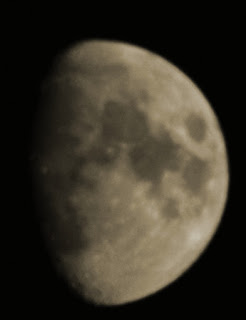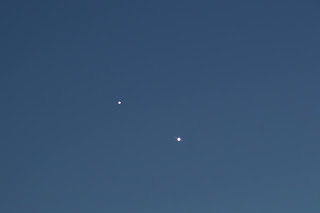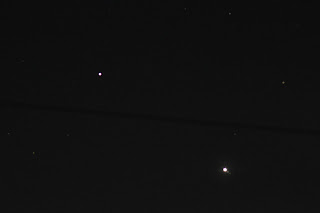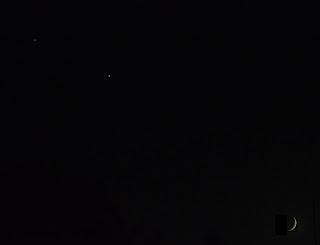December 31st 1200 GMT Sun
It was clear but very cold outside, so I checked the Sun with my binoculars and filters. I could see a single large sunspot about to rotate round the other side of the Sun.
December 31st 0200 GMT Betelguese
I compared Betelguese to some surrounding stars and estimated its magnitude to be about 0.7. Normalish, I guess.
December 30th 2255 GMT Moon
There had been a lot of cloud around and it was not until late evening that I managed to photograph the Moon. It looked very similar to what it looked like nearly 29 hours earlier.
December 29th 1800 GMT Moon
19 hours later, the Moon was in a clear patch of sky, As it was damp and cold outside, I snapped it, using the same settings as earlier.
December 29th 2300 GMT Moon
Conditions were slightly better than the night before, so I used ISO 100, ISO 100 and 1/1000 second exposure.
December 28th 0215 GMT Moon
I snapped the Moon under difficult conditions at 300mm focal length, ISO 100 and 1/250 second exposure.
December 27th 1125 GMT Sun
It was clear for a change. I started off with my PST for a hydrogen alpha shot. Visually, I could only see sunspots but I took a few afocal shots and processed the best. Although they are not as well resolved as with the Big Bear instruments, I was able to image some bright spots (plages) near the sunspots.
I also did a white light shoot with my Mak and DSLR at my usual settings (1540mm focal length, ISO 100 and 1/4000 second exposure). Despite stacking, I still had a rogue image of a hair, so I cropped the image to show just the region containing sunspots.
December 24th 1725 GMT Moon, Jupiter and Saturn
I caught the Moon and then Jupiter and Saturn together but neither were good shots.
December 20th 1545 GMT Moon
I saw Jupiter and Saturn close together, although truthfully they did not look any closer than they were the evening before. Clouds rolled in while I was setting up the camera. Fortunately, the Moon was in a clear patch of sky and I snapped it at 300mm focal length, ISO 100 and 1/320 second exposure.
December 20th 1330 GMT Sun
I had seen some plages and faculae on the Big Bear solar
observatory images. I had a rare look at the Sun though my PST. After some
etalonic tuning, I could make out some albedo features near the bottom of the
telescope image but nothing like what I had seen on the Big Bear website. I
went to fetch my camera but the view was soon lost to cloud!
December 19th 2255 GMT Deep Sky and Meteors
My intention was to see if I could catch some Geminid meteors at the tail end of the shower but, with an unexpectedly clear sky, I decided to do some deep sky shots first.
As the Pleaides were high in the sky, I hurt my neck by trying to photograph them and could not get anywhere near the target. Whilst I caught the Orion Great Nebula (M42) on camera, the results were blurred and with camera shake. Not a good start!
Fortunately, I had 7 good frames of the Hyades at 100mm focal length, ISO6400 and 2 seconds exposure. To be honest, I intended to adjust the exposure to 6 seconds but forgot. However, after stacking and processing the result was pleasing.
I stacked some early photos from the meteor hunt to catch the stars between Gemini and Ursa Major. Unfortunately, the signal-to-noise ratio was poor.
Despite taking over 400 shots, I did not catch a single meteor. It was rather disappointing but at least the early session produced a nice conjunction shot.
December 19th 1715 GMT Moon, Jupiter and Saturn
It was on and off during the day as to whether I would be able to see Jupiter and Saturn together. It cleared for a short while in the early evening. The Moon was also visible, so I shot it at 300mm focal length, ISO 100 and 1/250 second exposure.
I tried various combinations to get the best out of Jupiter and Saturn. The best result was with 300mm focal length, ISO 6400 and 1 second exposure.
December 15th 1755 GMT Meteor Hunt
The sky was clear (well-ish). I set up my camera in the usual way. I was having problems focussing, so I tested with Cygnus and Lyra.
I stacked some early images to get Auriga and Perseus together but the stack gave two Capellas, so just Perseus, similar to the photo on 12th.
At 1808 GMT, I caught a bright meteor in Perseus. It was not a Geminid.
At 1845 GMT thick cloud moved in, so I brought the camera in before it rained!
December 15th 1725 GMT Jupiter and Saturn
I caught them together using my usual settings. I saw two of Jupiter's moons.
December 12th 1810 GMT Meteor Hunt
I was hoping to catch some meteors from the Geminid shower. It was quiet, to start, with just some satellites. I stacked some of the early frames to show the constellation of Perseus.
At 1828 GMT, I caught a meteor in Perseus that was at the right direction to be a true Geminid. There is a possibility that it could have been moving in the opposite direction or could have been a co-incidental sporadic meteor.
December 12th 1805 GMT Jupiter and Saturn
An hour later, it was night. The planets were clear of the horizon and between some tree branches.
https://www.flickr.com/photos/philippughastronomer/50711429278/in/dateposted-public/
December 12th 1705 GMT Jupiter and Saturn
It was dusk but, having missed an opportunity before, wanted to catch Jupiter and Saturn together. I used ISO 1600 and 2 seconds exposure and caught both planets and three of Jupiter's moons.
December 5th 2305 GMT Moon
It had cleared somewhat, as the Moon was clear of any clouds. I used my DSLR at 300mm focal length, ISO 100 and 1/800 second exposure.
December 5th 2130 GMT Meteor Hunt
Conditions were not perfect, with cloud around but it was
almost mandatory to leave out the Geminid meteors. It was still early in the
shower, with the peak on about December 14th. My experiences with
meteors previously in the year had been mixed, with a good view of the Lyrids
and a few photos, to being clouded out for the Perseids, Leonids and Orionids.
I used my normal technique of taking multiple shots with an intervalometer with
my DSLR at 18mm focal length, ISO 6400 and 6 seconds exposure, with a 6 second
interval before the next one. Gemini was near the bottom of the frame.
I caught a meteor at 2207 GMT. It was not a shower meteor but most astronomers would take it!
I processed 10 early frames to reveal Auriga.
It was not completely dark but the weather had been
unreliable for several days. I started off with my prime target of Jupiter and
Saturn together. They fitted comfortably into my camera field of view at 300mm
focal length, ISO 6400 and 2 seconds exposure, standard stuff. There were a couple of faint dots near Saturn that could have been Titan but there were definitely three of Jupiter's moons, all to the left (east).
With Melotte 20 and the Pleiades (M45) well clear of the
horizon, I took several frames, using the same settings, hoping to stack some
images.
I disturbed the focus while switching targets and Deep Sky Stacker was not co-operating, so I shrunk the image to compensate.
Same treatment for Melotte 20 but I felt that the result was better.
































































